
Prehistoric sites within 4km of SX 63870 83130
Guidance for walkers: The monuments featured in this database are archaeological treasures and need to be protected and preserved - please do not disturb any sites. Please check access and firing times before visiting sites, not all sites listed are on open access land. Firing ranges and boundaries of open access areas are marked on the OL28 OS Dartmoor Explorer map. Please stick to the country code and consider giving support to the numerous agencies that help to keep Dartmoor a fabulous natural and historic environment!
About the database listings: In all listings clicking on the photo or the site name will open a page for the site with a larger photo and further details from the database. The database now has over 6680 records covering nearly all publicly listed sites on Dartmoor including around 4800 round houses. This level of detail is of interest to archaeologists but tends to swamp listings of sites more likely to be of interest for walkers. For this reason, the listings default to around 550 core sites only. These are the stone circles, stone rows and the ring cairns listed by Turner. The default search radius is 2 km. The controls below the map can be used to start a new search by entering a 6- or 8-digit reference (without the prefix "SX"). The search radius can be specified and you can add incremental Display layers of detail on top of the core sites. If using a more detailed layer you will need to decrease the search radius to avoid getting hundreds of search results.
- Core sites Default listing of core sites consisting of stone circles & rows and some of the major ring cairns.
- Plus cairns adds approx. 1000 cairns and other minor sites not included in the core listings but excluding round houses.
- Plus round houses adds approx. 4800 round houses.
- Plus non-sites adds in the records for sites that no longer exist or are not prehistoric sites.
- Plus duplicates adds records excluded as duplicates. Those maybe duplicate records in external listings (e.g. the Historic Environment Records). For example, some sites have been identified as cairns in some listings and interpreted as round houses in other listings and both records appear.
These listings have incorporated, matched up and merged all of the records from all of the major archaeological listings including: Worth, Grinsell, Turner, Butler, Bill Radcliffe, Sandy Gerrard, Megalithic Portal, the National Monument Records and the Historic Environment Records. The author would like to thank Bill, Sandy, the lovely people both at Megalithic Portal (especially Anne Tate who did an amazing job to link listings) and at ACE Archaeology for collaborative work over the years to synchronise and correct listings across the various websites which now interlink. A culmination of years of work the final merger of cairn records took 3 months of cross referencing in 2017 the result being a snapshot of the records at that time. This data has in turn been refined since by field work and research. The round house data was supplied by Sandy Gerrard. Grid references are in order of accuracy: from Google Earth satellite, if visible and found, from a Garmin GPS reading, if visited by the author and from the literature otherwise. Individual site pages will state the source of the grid reference and provide satellite imagery. If a site listing lacks a photo it has not yet been visited by the author in which case the grid reference is from the literature.
Currently the database only includes sites which can be represented by a grid reference. Reaves are not included as they require GIS shape technology which is beyond the current capability of this system. To see the sources for the records, look at the tables on the resources menu. The database listings can also be viewed on a Google map and downloaded as GPS datasets for Garmin devices.
Corrections, or any feedback or suggestions are very welcome, email: info@dartmoorwalks.org.uk.
NOTE: Clicking on the icons for each monument in the map will give the name of the site. You can zoom in and out and drag the map around.
List of sites within 4km of SX 63870 83130
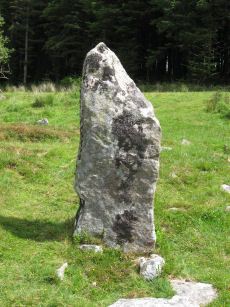
Assycombe Standing Stone
Prehistoric Dartmoor Walks: Dartmoor Site: Assycombe Double Stone Row
OS Map: SX 66101 82649
HER: MDV6537
Megalithic Portal: 1738
PMD: Assycombe Standing Stone
ShortName: SS Assycombe
Butler map: 35.19
DPD page: 135
Notes: Bronze Age stone row and cairn, Assycombe. The double stone row is 120m long terminating in the cairn at the North-East end. The South-West end is blocked by a stone 2.0m high. The largest stone, 2m high, lies at the E end and was re-erected re-erected by Baring-Gould in 1892 or 1893. The cairn is 8.4m in diameter and 0.6m high.
Nearby sites: SX 66101 82649
Distance: 2.28km
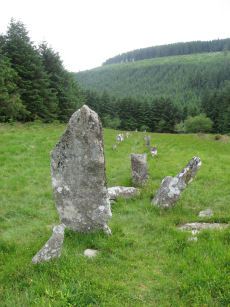
Assycombe Stone Row
Prehistoric Dartmoor Walks: Dartmoor Site: Assycombe Double Stone Row
OS Map: SX 66095 82641
HER: MDV6537
Megalithic Portal: 1738
The Stone Rows of GB: Assycombe Stone Row
PMD: Assycombe Stone Row
ShortName: SR Assycombe
Butler map: 35.19
DPD page: 135
Notes: "Bronze Age stone row and cairn, Assycombe. The double stone row is 120m long terminating in the cairn at the North-East end. The South-West end is blocked by a stone 2.0m high, re-erected there by Baring-Gould. The cairn is 8.4m in diameter and 0.6m high. Scheduled." Also from Burnard's 1892 field notes: The row, which starts from a ruined cairn, consists of 84 standing stones, and extends 800 feet E. and W., running in two rows down the hill towards Assycombe. It terminates towards the W. in a stone lying prone, 5' 9" long. 2'' wide. The avenue is from 5' to 6' wide, inner measurement. The stones composing the row are 18" high, and down to 6".
Nearby sites: SX 66095 82641
Distance: 2.28km
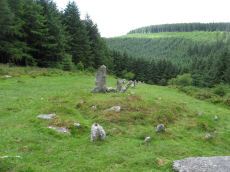
Assycombe Hill Encircled Cairn and Cist
Prehistoric Dartmoor Walks: Dartmoor Site: Assycombe Double Stone Row
OS Map: SX 66102 82650
HER: MDV6538
Megalithic Portal: 45814
PMD: Assycombe Stone Row
Alternate name: Assycombe Hill Stone Row Encircled Cairn and Cist
ShortName: CT Assycombe
Butler map: 35.19
Butler Vol 5: p.232 & Fig.164
DPD page: 135
Grinsell: LYD 26
Turner: F16
Notes: The cairn at the E end is in line with the N of the two rows. It measures 8.4m in diameter and is 0.6m high. It contains a large quantity of stone; two stones in the centre, set at right angles to each other around a hollow, suggest the remains of a cist.
Nearby sites: SX 66102 82650
Distance: 2.28km
Broadun Enclosed Settlement
OS Map: SX 6354 7993
HER: MDV5946
Megalithic Portal: 26043
ShortName: ES:Broadun
Notes: "An enclosed settlement, maximum dimensions 300m NE/SW by 250m NW/SE, giving an area of 6ha. Enclosure cut through on SE by a leat, but wall still visible. Inside are 36 huts, and a further 3 outside. Condition of huts mainly poor. Average internal diameter is 3.7m: the largest is 13m by 10.5m, the smallest 2.5m. The enclosure wall appears contemporary with or later than the huts. The interior of the enclosure appears to have been cleared." See also HER entry 6800
Nearby sites: SX 6354 7993
Distance: 3.22km
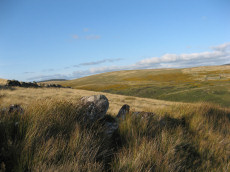
Broadun Ring Enclosed Settlement
OS Map: SX 63704 80192
HER: MDV6746
Megalithic Portal: 26048
ShortName: ES BroadunRing
Nearby sites: SX 63704 80192
Distance: 2.94km
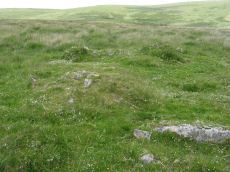
Chittaford Down Platform Cairn Circle
OS Map: SX 63502 79203
HER: MDV5832
Megalithic Portal: 42726
PMD: Archerton
Alternate name: Chittaford Down 1 Platform Cairn Circle
ShortName: PC Chittaford
Butler map: 27.18.1
Butler Vol 5: p.170 & Fig.109
Grinsell: LYD 38
Turner: E14
Notes: "Remains of a cairn, visible as a turf covered stony mound. The NE quadrant is robbed out but around the rest of the periphery are parts of a kerb of small boulders, some set on edge, giving a diameter of 6.5m NW-SE. Maximum height 0.6m in the SW quadrant, but elsewhere the interior is badly robbed." Butler says there is a possible end slab of a cist.
Nearby sites: SX 63502 79203
Distance: 3.94km
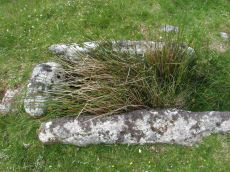
Chittaford Down Platform Cairn Circle and Cist
OS Map: SX 63687 79463
HER: MDV5932
Megalithic Portal: 52177
PMD: Chittaford Down
Alternate name: Chittaford Down 3 Platform Cairn Circle and Cist
ShortName: CT Chittaford
Butler map: 27.18.3
Butler Vol 5: p.160 & Fig.100
DPD page: 112
Grinsell: LYD 39
Turner: E28
Barrow Report: 57
Notes: "A cist about 350 yards north of Archerton House. It has an irregular shape no coverstone and stands in the centre of a 14ft. diameter ruined cairn. There are traces of an enclosing ring of stones. Excavation in 1900 recovered wood charcoal and a worked flint flake from a small pit within the cist. Under the eastern side stone an archer's polished stone wrist guard was found". Lethbridge diagram and photo bottom p.112. Butler Chittaford Down 3 - Vol. 2. Map 27.18 (diagram Vol. 5. p.160).
Nearby sites: SX 63687 79463
Distance: 3.67km
East Lowton Settlement
OS Map: SX 666 837
HER: MDV107002
Megalithic Portal: 34966
ShortName: ST:EastLowton
Nearby sites: SX 666 837
Distance: 2.79km
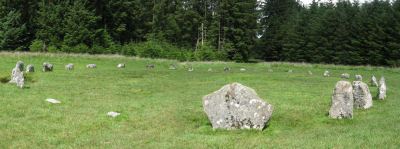
Fernworthy Stone Circle
Prehistoric Dartmoor Walks: Dartmoor Site: Fernworthy Stone Circle
OS Map: SX 65486 84126
HER: MDV6534
Megalithic Portal: 530
PMD: Fernworthy Stone Circle
ShortName: SC Fernworth
DPD page: 138
Turner: G13
Notes: The Fernworthy circle is part of a group of ceremonial monuments including 3 stone rows and 5 cairns that may once have rivalled Merrivale and Shovel Down as ceremonial centres. The site is in a small clearing in Fernworthy Forrest off the path to Teignhead Farm. The circle is remarkably intact with all but 2 stones still in their original places ... It is 20m in diameter and consists of 27 small stones. The stone rows and cairns probably came later and surround the site. The circle was excavated by the Dartmoor Exploration Committee in 1897. They found that the interior of the circle was covered in a layer of charcoal suggesting that it had been the scene of very many fires - perhaps funeral pyres or feasts. See also Legendary Dartmoor: Dartmoor's Fernworthy Stone. DNP Post 3D.
Nearby sites: SX 65486 84126
Distance: 1.90km
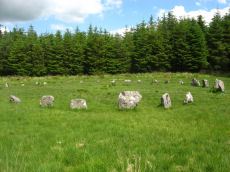
Fernworthy Ceremonial Complex
Prehistoric Dartmoor Walks: Dartmoor Site: Fernworthy Stone Circle
OS Map: SX 6548 8412
HER: MDV6534
Megalithic Portal: 35937
PMD: Fernworthy
ShortName: CX Fernwthy
DPD page: 138
Notes: Lethbridge p.138
Nearby sites: SX 6548 8412
Distance: 1.89km
Fernworthy Settlement
OS Map: SX 648 837
HER: MDV6731
Megalithic Portal: 10485
ShortName: ST:Fernworthy
Nearby sites: SX 648 837
Distance: 1.09km
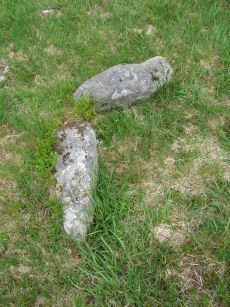
Fernworthy Cist
Prehistoric Dartmoor Walks: Dartmoor Site: Fernworthy Stone Circle
OS Map: SX 65491 84100
HER: MDV6719
Megalithic Portal: 35826
PMD: Fernworthy
Alternate name: Fernworthy 2 Cist
ShortName: CT Fernworth
Butler map: 35.15.2
Butler Vol 5: p.36 & Fig.13
DPD page: 138
Grinsell: LYD 23
Notes: The remains of this cist are in the 6m diameter barrow at the N end of the Fernworthy S.E. stone row. The cist in the centre is represented by two stones set at right angles, 0.4m tall internally. Excavated by the Dartmoor Excavation Committee in 1898. A lot of burnt bone was found. DNP Post 6D. Butler Vol. 2. Map 35.15.2 (diagram Vol. 5. p.36 - row 2). Newman Barrow B.
Nearby sites: SX 65491 84100
Distance: 1.89km
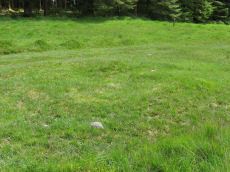
Fernworthy (SW) Encircled Cairn
Prehistoric Dartmoor Walks: Dartmoor Site: Fernworthy Stone Circle
OS Map: SX 65483 84101
HER: MDV14885
Megalithic Portal: 35827
Alternate name: Fernworthy 3 Encircled Cairn
ShortName: EC FernworthyS
Butler map: 35.15.3
Butler Vol 5: p.36 & Fig.14
Grinsell: LYD 21
Turner: F25
Notes: Newman Barrow A. Small turf-covered cairn at the northern end of the western double stone row south of Fernworthy stone circle forming part of the Froggymead ceremonial complex. It measures 6.5 metres in diameter and has a central hollow resulting from excavation in 1898. Two rings of orthostats, 7m and 5m diameter, around cairn 4.5m diameter and 0.2m high (Turner). It once had a retaining circle of small stones but only three were visible in 2013. DNP Post 2D. Turner F25.
Nearby sites: SX 65483 84101
Distance: 1.88km
Fernworthy Barrow C Cairn
OS Map: SX 65485 84047
HER: MDV14887
Megalithic Portal: 35829
Alternate name: Fernworthy 4 Cairn
ShortName: CN:FernworthyC
Butler map: 35.15.4
Grinsell: LYD 22
Notes: Newman Barrow C.Cairn forming part of the cermonial complex at Froggymeade. Sitated at the southern end of the eastern stone row to the south of Fernworthy stone circle. It was excavated in 1898 but had previously been disturbed. Only one small flint flake was found.
Nearby sites: SX 65485 84047
Distance: 1.86km
Fernworthy E. Encircled Cairn
Prehistoric Dartmoor Walks: Dartmoor Site: Fernworthy Stone Circle
OS Map: SX 65561 84090
HER: MDV6560
Megalithic Portal: 3234
Alternate name: Fernworthy 5 Encircled Cairn
ShortName: EC:FernworthyE
Butler map: 35.15.5
DPD page: 138
Grinsell: LYD 24
Turner: F4
Notes: Newman Barrow D. "5.8m diameter. Has 3 stones spaced on the east side. A beaker, flint knife, dress fastener and a piece of bronze were discovered when the cairn was excavated in 1898". The crushed beaker. When reconstructed it became one of Dartmoor's most important Bronze Age finds and is now on display in Plymouth City Museum along with the other artifacts retrieved. DNP Post 7D.
Nearby sites: SX 65561 84090
Distance: 1.94km
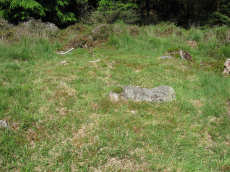
Fernworthy N. Cairn
OS Map: SX 65539 84333
HER: MDV6563
Megalithic Portal: 35828
The Stone Rows of GB: Fernworthy 1
PMD: Fernworthy N Row
Alternate name: Fernworthy 1 Cairn
ShortName: CN FernworthyN
Butler map: 35.15.1
Grinsell: LYD 20
Notes: Newman Barrow E. Remains of a small cairn at the northern terminus of the double stone row north of the Fernworthy stone circle. The cairn has been damaged by past tree planting and the feature can be hard to identify as the remains are low to the ground and spread far beyond its original form. Radcliffe quotes Butler and also refers to HER/SMR number 6556 or 6562. "The 1898 plan shows a mound with a stone alongside as its northern terminus, probably a cairn, 1, with a retaining circle. This stone is still visible together with another at an angle, perhaps one side of a cist ..." (Butler Vol 2 pp. 164-5)
Nearby sites: SX 65539 84333
Distance: 2.06km
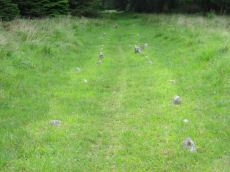
Fernworthy N. Stone Row
Prehistoric Dartmoor Walks: Dartmoor Site: Fernworthy Stone Circle
OS Map: SX 65538 84336
HER: MDV6562
Megalithic Portal: 1933
The Stone Rows of GB: Fernworthy 1
PMD: Fernworthy B Stone Row
Alternate name: Fernworthy 1 Stone Row
ShortName: SR Fernwthy N
Butler map: 35.15.1
DPD page: 138
Notes: Butler Row 1. "To the N of Fernworthy stone circle is a double stone row. At its N end are the disturbed remains of a barrow. The row survives well for 125m although beyond this (to the N) it has been heavily disturbed by forestry activity as far as the barrow. The plan of 1898, made prior to afforestation, shows the N end of the double row as already `buried or lost'. The surviving part of the double row contains paired, low stones 0.8m to 1.4m apart, averaging 0.3m high, although many are flush with the ground. The tallest stones are at the S end. The alignment of the row is tangential to the circle (SX 68 SE 56). The barrow at the N end of the row measures 6m in diameter, although it is very amorphous due to tree planting. there is a large proportion of stone in the centre of the low mound, as well as some amorphous scarping and one large upright slab." DNP Post 8D
Nearby sites: SX 65538 84336
Distance: 2.06km
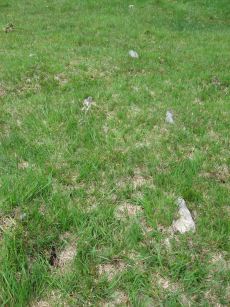
Fernworthy S.E. Stone Row
Prehistoric Dartmoor Walks: Dartmoor Site: Fernworthy Stone Circle
OS Map: SX 6549 8407
HER: MDV6556
Megalithic Portal: 10484
The Stone Rows of GB: Fernworthy 2
PMD: Fernworthy C Stone Row
Alternate name: Fernworthy 2 Stone Row
ShortName: SR Fernwthy SE
Butler map: 35.15.2
DPD page: 138
Notes: Butler Row 2. "Centred at SX 65518404 is a cairn. 45m to the N at SX 65508409 is a barrow containing the remains of a cist. Between the two are the very fragmented remains of an alleged double stone row running N to S parallel to another row (SX 68 SE 59) which leads towards Fernworthy Stone Circle. The row, barrow and cairn have all been comprehensively damaged by afforestation and the digging of the adjacent drainage channels. Seven stones survive of an alignment but there is little evidence that it was a double row. The barrow at the N end of the row measures up to 6m in diameter and is 0.4m high, although its shape is obscured by drainage channels. The cist in the centre is represented by two stones set at right angles, 0.4m tall internally. The cairn at the S end of the row measures 7.3m N to S by 8.5m and is 0.5m high. There is a large amount of surface stone on and around it." DNP Post 5D.
Nearby sites: SX 6549 8407
Distance: 1.87km
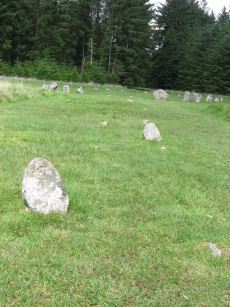
Fernworthy S.W. Stone Row
Prehistoric Dartmoor Walks: Dartmoor Site: Fernworthy Stone Circle
OS Map: SX 65479 84105
HER: MDV14886
Megalithic Portal: 1934
The Stone Rows of GB: Fernworthy 3
PMD: Fernworthy A Stone Row
Alternate name: Fernworthy 3 Stone Row
ShortName: SR Fernwthy SW
Butler map: 35.15.3
DPD page: 138
Notes: Butler Row 3. "A disturbed double stone row is centred SX 65488408. It is 21m long and is oriented N to S. At the N end is a cairn (SX 68 SE 58) offset slightly W of the alignment of the row. Beyond this to the N is Fernworthy Stone Circle (SX 68 SE 56). The S end of the row is not very well preserved. The plan of 1898 depicts it terminating at a stone in the face of a wall, although the wall has since been removed. The stones in the row average 0.5m to 0.6m tall and lie in an area of amorphous modern earthworks up to 0.3m deep." DNP Post 1D.
Nearby sites: SX 65479 84105
Distance: 1.88km
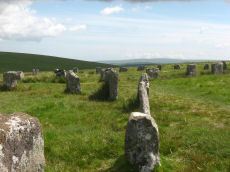
Grey Wethers (N) Stone Circle
Prehistoric Dartmoor Walks: Dartmoor Site: Grey Wethers Double Stone Circle
OS Map: SX 63875 83161
HER: MDV6758
Megalithic Portal: 532
PMD: Grey Wethers Stone Circles
ShortName: SC Grey Weth N
DPD page: 134
Turner: G4
Notes: "Northern stone circle of the pair known collectively as The Grey Wethers. This circle measures 31.5 metres in diameter and is denoted by 20 upright granite slabs with an average height of 1.1 metres. Excavations carried out by the Dartmoor Exploration Committee towards the end of the 19th century revealed a layer of charcoal covering the original ground surface. A shallow trench visible leading through the southern circle may be the result of this excavation. The circle was restored at this time"
Nearby sites: SX 63875 83161
Distance: 0.03km

Grey Wethers (S) Stone Circle
Prehistoric Dartmoor Walks: Dartmoor Site: Grey Wethers Double Stone Circle
OS Map: SX 63874 83121
HER: MDV6759
Megalithic Portal: 532
PMD: Grey Wethers Stone Circles
ShortName: SC Grey Weth S
DPD page: 134
Turner: G2
Notes: This site is one of the most impressive on Dartmoor. The circles were restored in 1909 by Burnard. At the time only 9 stones remained standing in the north circle and 7 in the south circle. It is thought that the reconstruction is fairly accurate. The circles are separated by a few meters and are almost identical. Both circles have 30 stones and diameters very close to 33 m and they are within 2 degrees of being on an exact north to south alignment. The slight differences between the two circles could even be a result of the restoration. Apparently "wether" is an old English name for sheep and legend has it that a drunken farmer leaving the Warren House Inn was persuaded that the Grey Wethers were a desirable flock for sale! See also, Legendary Dartmoor: Grey Wethers
Nearby sites: SX 63874 83121
Distance: 0.01km
Hangingstone Hill Cairn
OS Map: SX 61704 86136
HER: MDV4377
Megalithic Portal: 45858
ShortName: CN:Hanging
Butler map: 41.5
Grinsell: LYD 6
Notes: "A low, flat-topped cairn located on the summit of Hangingstone Hill. It measures 17.5m north to south by 15.0m at base and is maximum 1.4m high. It is apparently composed of medium sized granite slabs and boulders with a thin and patchy covering of turf. An ovoid hollow, 3.1m north to south by 2.0m and 0.3m deep, containing the stump of the flag pole (noted in the Devon SMR) lies slightly east of centre. A Range Wardens' hut encroaches on the southern side of the cairn. A considerable amount of peat has built up or has been deposited on the eastern side elongating the mound by some 10m in this direction." Partially excavated and repaired in 2016, see HER record. Butler Map 41.5 (Vol 2).
Nearby sites: SX 61704 86136
Distance: 3.71km
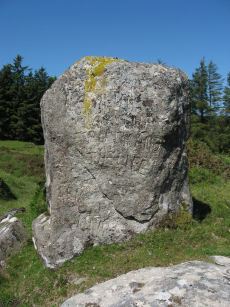
Heath Stone Standing Stone
Prehistoric Dartmoor Walks: Dartmoor Site: Hurston Ridge Double Stone Row
OS Map: SX 6712 8375
HER: MDV6650
Megalithic Portal: 14933
ShortName: SS Heath Stone
Butler map: 25.
Notes: The original Heath Stone was a boundary stone which was referred to in the Perambulation of the Forest of Dartmoor in 1240 and some very early maps. According to Butler (Vol. 2 Map 25 p.32) the stone carved with a biblical inscription in 1970 that is currently known as the Heath Stone is unlikely to have been the original Heath Stone as it is in a useless position to be of any use as a boundary stone. The stone was not included in maps from the 18th century and then reappeared in a different location. It is doubtful that the current stone is the original or that it is prehistoric. Crossing suggests that the large standing stone in the Hurston Ridge stone row is the actual Heath Stone. See also, Legendary Dartmoor: The Dartmoor Heathstone
Nearby sites: SX 6712 8375
Distance: 3.31km
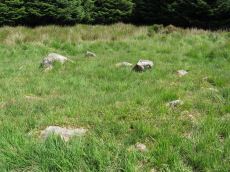
Hemstone Rocks Platform Cairn Circle
OS Map: SX 64856 83806
HER: MDV6730
Megalithic Portal: 45619
PMD: Hemstone Rocks
Alternate name: Hemstone Rocks N.3 Platform Cairn Circle
ShortName: PC Hemstone
Butler map: 35.7.3
Grinsell: LYD 17b
Turner: E12
Notes: Next to Turner ring cairn D9. "Remains of a cairn 8.0 metres diameter and up to 0.2 metres high to the north of the hut settlement. There are two pits cut into it, probably the result of work carried out by the Dartmoor Exploration Committee in 1901." DNP Site 9F.
Nearby sites: SX 64856 83806
Distance: 1.20km
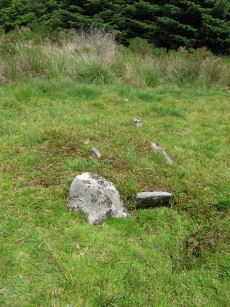
Hemstone Rocks Ring Setting Cairn and Cist
OS Map: SX 64852 83850
HER: MDV6729
Megalithic Portal: 52522
PMD: Hemstone Rocks
Alternate name: Hemstone Rocks N.2 Ring Setting Cairn and Cist
ShortName: CT Hemstone
Butler map: 35.7.2
Grinsell: LYD 17a
Turner: D9
Notes: There are 3 cairns in the vicinity and they are according to Newman [2013] impossible to match up with the old reports. These cairns were excavated by Baring-Gould in 1900. A flint flake was found in the cist. There is also a rectangular pit in this cairn which could be from the 1900 excavation. See also: MDV48854. DNP Site 8F. Butler Hemstone Rocks N. 1 - Vol. 2. Map 35.7. Central cist. Next to Turner Platform Circle E12.
Nearby sites: SX 64852 83850
Distance: 1.22km
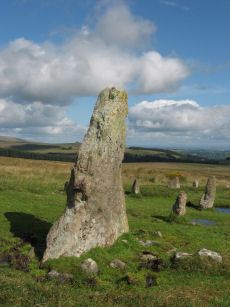
Hurston Ridge Standing Stone
Prehistoric Dartmoor Walks: Dartmoor Site: Hurston Ridge Double Stone Row
OS Map: SX 67268 82444
HER: MDV6541
Megalithic Portal: 8345
PMD: Hurston Ridge Standing Stone
ShortName: SS HurstonRidg
Butler map: 25.9
DPD page: 136
Notes: Hurston Ridge is one of the best examples of a double stone now on Dartmoor. At the south end is a cairn 22feet in diameter. The space between the rows widens intentionally as it approaches the cairn. The first stone from the south in the eastern row is the largest stone and stands 5 feet 10 inches high. Crossing suggests this may have been the original Heath Stone. A cinerary urn, in fragments except for the rim, was discovered in the cairn in 1900. Restored, the urn, 18 3/4 inches high, 16 inches in diameter at the rim and 8 inches in diameter at the base was revealed as an unusually large and handsome bipartite Overhanging rim or crowned urn of Middle Bronze Age type.
Nearby sites: SX 67268 82444
Distance: 3.47km

Hurston Ridge Settlement
OS Map: SX 674 825
HER: MDV6668
Megalithic Portal: 34979
ShortName: ST HurstonRidg
Butler map: 25.9
Nearby sites: SX 674 825
Distance: 3.59km
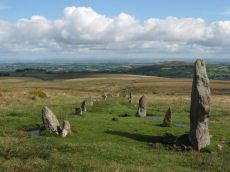
Hurston Ridge Stone Row
Prehistoric Dartmoor Walks: Dartmoor Site: Hurston Ridge Double Stone Row
OS Map: SX 67260 82437
HER: MDV6541
Megalithic Portal: 8345
The Stone Rows of GB: Hurston Ridge
PMD: Hurston Ridge Stone Row
ShortName: SR Hurston
Butler map: 25.9
Butler Vol 5: p.228 & Fig.161
DPD page: 136
Notes: .Worth: Watern Hill. "A stone alignment which includes two parallel lines of upright stones leading downslope for 143 metres from a round cairn. The lower end of the alignment is denoted by a blocking stone. Midway along the alignment a length of later enclosure walling crosses the row. The cairn at the upper end of the alignment measures 5.9 metres in diameter and stands up to a height of 0.6 metres. A large slab denoting the north eastern edge of the cairn may represent a second blocking stone of the associated alignment. A cinerary urn was found in the cairn." A number of the stones were restored to their original sockets in 1894. A broken hand axe was discovered in the pit in which one of the stones had stood near to the menhir next to the cairn.
Nearby sites: SX 67260 82437
Distance: 3.46km
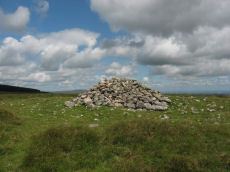
King's Oven (Water Hill) Cairn
OS Map: SX 67158 81299
HER: MDV6674
Megalithic Portal: 34690
PMD: Water Hill Possible Chambered Cairn
Alternate name: Water Hill 1 Cairn
ShortName: CN Kings Oven
Butler map: 26.5.1
Butler Vol 5: p.156 & Fig.95
Grinsell: CHA 6
Notes: Situated at SX 67158129 on the rounded summit of Water Hill is the remains of a substantial round cairn 18.0 metres in diameter and up to 1.4 metres high in the east and 0.9 metres in the west. The whole of the central area of the cairn has been robbed to construct a superimposed modern boundary cairn 4.0 metres in diam and 2.1 metres high. This has given a 'dished' appearance to the cairn proper. Several large slabs averging 0.8 metres by 0.7 metres scattered around the base of the boundary cairn may be the remains of a destroyed cist.
The southern flat topped cairn measures 18 metres in diameter and 1.5 metres in height and is surmounted by a modern stone pile. A large slab situated to the south of this pile may have been part of a cist.
Nearby sites: SX 67158 81299
Distance: 3.76km
Lowton Brook W. Settlement
OS Map: SX 663 834
HER: MDV104672
Megalithic Portal: 24262
ShortName: ST:LowtonBrW
Nearby sites: SX 663 834
Distance: 2.44km
Metherall Settlement
OS Map: SX 668 840
HER: MDV6624
Megalithic Portal: 15138
ShortName: ST:Metherall
Barrow Report: 56
Nearby sites: SX 668 840
Distance: 3.06km

Quintins Man Cairn
OS Map: SX 62101 83873
HER: MDV6765
Megalithic Portal: 45860
PMD: Quintins Man
ShortName: SSxQuintinsMan
Butler map: 34.1
Notes: "A cairn. The name implies a standing stone, but there is no knowledge of one in living memory." [worth] See also, Legendary Dartmoor: Dartmoor's Quintin's Man
Nearby sites: SX 62101 83873
Distance: 1.92km

Quintins Man A Ancient Pool
OS Map: SX 62102 83952
HER: MDV27278
ShortName: PO QuintinsA
Notes: "Previously identified as a prehistoric barrow, survey work in 1995 suggested this to be a natural feature. One of over 40 'sacred' pools identified by Greeves (2019) that may have prehistoric origin. Lies north of the Quintin's Man cairn."
Nearby sites: SX 62102 83952
Distance: 1.95km

Quintins Man B Ancient Pool
OS Map: SX 62053 84056
HER: MDV127217
ShortName: PO QuintinsB
Notes: "A pool measuring 20 by 16m. One of over 40 such 'sacred' pools identified on Dartmoor that are thought to have potentially been designed during the prehistoric period."
Nearby sites: SX 62053 84056
Distance: 2.04km

Quintins Man C Ancient Pool
OS Map: SX 61972 84365
HER: MDV127218
ShortName: PO QuintinsC
Notes: "Pool north of Quintin's Man measures 12 by 8m. One of over 40 such 'sacred' pools identified on Dartmoor that are thought to have potentially been designed during the prehistoric period"
Nearby sites: SX 61972 84365
Distance: 2.26km
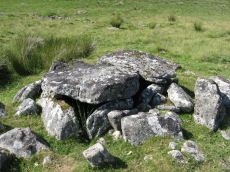
Roundy Park, Postbridge Cist
OS Map: SX 63920 79669
HER: MDV5935
Megalithic Portal: 26041
PMD: Roundy Park
Alternate name: Roundy Park Cist
ShortName: CT Roundy Park
Butler map: 27.4
Butler Vol 5: p.22 & Fig.3
DPD page: 113
Grinsell: LYD 40
Barrow Report: 21
Notes: One of the largest cists on Dartmoor. Discovered in August 1893 by Robert Burnard, who was responsible for the restoration of the grave. Lethbrdige diagram p.112, photo p.113. Butler Vol. 2. Map 27.4 (diagram of location p.41, diagram of site Vol. 5 p.22)
Nearby sites: SX 63920 79669
Distance: 3.46km
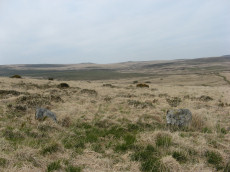
Shovel Down Stone Circle
Prehistoric Dartmoor Walks: Dartmoor Site: Shovel Down Ceremonial Complex
OS Map: SX 65829 86196
HER: MDV29944
Megalithic Portal: 1259
PMD: Shovel Down Stone Circle
ShortName: SC Shovel Down
Butler map: 36.6
DPD page: 139
Turner: G15
Notes: "The remains of an alleged stone circle lie on the gentle NE facing slope of Shovel Down 200m SW of Batworthy Corner. Three upright stones, between 0.3m and 0.75m high, are visible. The two close-set NE stones display smaller packing stones in the erosion hollows at their bases. The third stone is partly obscured by the bank of the South Hill Leat (SX 68 SW 97). It is possible that these stones constitute the remains of a stone circle however, no such feature is noted in the antiquarian records so it must remain a doubtful site". In fact a sketch of the Shovel Down rows made by Wilkinson in 1860 marks and illustrates "stones" at the location of the stone circle. For a photo, see Megalithic Portal: Shovel Down NW stone circle. Lethbridge pp.139-145, diagram p.139.
Nearby sites: SX 65829 86196
Distance: 3.64km
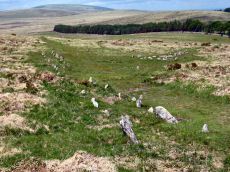
Shovel Down Ceremonial Complex
Prehistoric Dartmoor Walks: Dartmoor Site: Shovel Down Ceremonial Complex
OS Map: SX 6597 8596
Megalithic Portal: 10387
PMD: Shovel Down
ShortName: CX Shovel Down
Butler map: 36.6
DPD page: 139
Notes: Ceremonial complex including multiple stone rows and a small stone circle. Lethbridge pp.139-145. Interesting old sketches on the RAMM website: Emanuel Jeffery sketches of Shovel Down stone rows (1839) and Emanuel Jeffery sketch of Stone Row to Shovel Down Long Stone (1839)
Nearby sites: SX 6597 8596
Distance: 3.52km
Shovel Down Settlement
OS Map: SX 658 859
HER: MDV6163
Megalithic Portal: 10386
ShortName: ST:ShovelDown
Butler map: 36.4
Nearby sites: SX 658 859
Distance: 3.38km
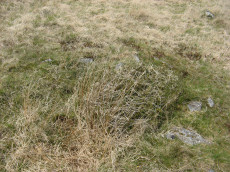
Shovel Down Cist
Prehistoric Dartmoor Walks: Dartmoor Site: Shovel Down Ceremonial Complex
OS Map: SX 65993 85924
HER: MDV6182
Megalithic Portal: 28953
PMD: Shovel Down
Alternate name: Shoveldown Rows 4 Cist
ShortName: CT Shovel Down
Butler map: 36.7
Butler Vol 5: p.223 & Fig.155
Grinsell: CHA 1
Notes: Robbed cist no longer visible. The Shovel down double row C (Worth Row C, Butler Rows 4) terminates at its southern end in a cairn - the cist has been robbed from the cairn. Visited 16/05/19 - a rectangular cist shaped hole can be clearly seen with reeds growing from it. No sign of a cist. Butler Shoveldown Rows 4 Vol. 2. Map 36.7 (diagram Vol. 5. p.223).
Nearby sites: SX 65993 85924
Distance: 3.51km
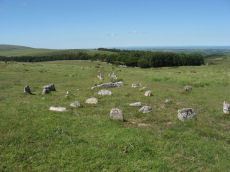
Shovel Down Fourfold Cairn Circle
Prehistoric Dartmoor Walks: Dartmoor Site: Shovel Down Ceremonial Complex
OS Map: SX 65958 86025
HER: MDV6158
Megalithic Portal: 3464
PMD: Fourfold Circle
Alternate name: Fourfold Circle Cairn Circle
ShortName: CC Shovel4Fold
Butler map: 36.7
DPD page: 143
Grinsell: GID 3
Turner: G31
Barrow Report: 56
Notes: "Fourfold Circle a sub-circular configuration of four apparently concentric stone rings. The outer ring has a diameter of 9m, the others have diameters of 6.4m, 4.7m and 2.4m respectively. The monument comprises 29 visible stones. Most are approximately 0.3m in height although they vary from 0.1-0.55m. The middle two rings define the bottom and top of the scarp of a small earthern cairn apparently an integral part of the monument. It is most pronounced on the E (downslope side). In the centre is a roughly sub-circular pit measuring 1.3m by 0.7m and 0.45m deep; it is probably the remains of a badly robbed cist. On the N side are two large fallen stones. When upright they may have served as a focal point for the end of the stone row " Lethbridge 139-145, diagram p.139.
Nearby sites: SX 65958 86025
Distance: 3.57km
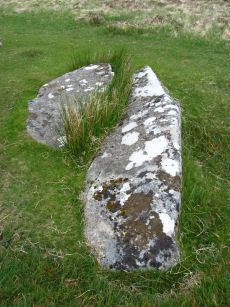
Shovel Down Fourfold Circle Standing Stone
Prehistoric Dartmoor Walks: Dartmoor Site: Shovel Down Ceremonial Complex
OS Map: SX 65958 86033
HER: MDV6158
Megalithic Portal: 3464
PMD: Fourfold circle
ShortName: SS Shovel Down
Butler map: 36.6
DPD page: 143
Barrow Report: 56
Notes: "The south end [of the double row] is aligned on a cairn 'Fourfold Circle' (SX 68 NE 17) and separated from it by two massive fallen stones, one 'needle-shaped' and similar to the 'Longstone' (SX 68 NE 39), southern terminal of stone row 'E'."
Nearby sites: SX 65958 86033
Distance: 3.58km
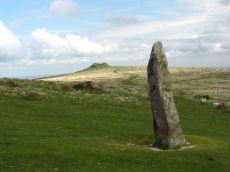
Shovel Down Long Stone Standing Stone
Prehistoric Dartmoor Walks: Dartmoor Site: Shovel Down Ceremonial Complex
OS Map: SX 66031 85683
HER: MDV6149
Megalithic Portal: 10378
PMD: Shovel Down
ShortName: SS Long Stone
Butler map: 36.6
Butler Vol 5: p.56 & Fig.34
DPD page: 140
Notes: The Long Stone has been used as a boundary stone but it appears to be the terminal stone for a Bronze Age stone row and it may be of a contemporary date. See also, Legendary Dartmoor: The Shoveldon Longstone
Nearby sites: SX 66031 85683
Distance: 3.34km

Shoveldown A Stone Row
Prehistoric Dartmoor Walks: Dartmoor Site: Shovel Down Ceremonial Complex
OS Map: SX 65947 86029
HER: MDV6168
Megalithic Portal: 2130
The Stone Rows of GB: Shoveldown 3
PMD: Shovel Down D-E Stone Row
Alternate name: Shoveldown 3 Stone Row
ShortName: SR Shovel A
Butler map: 36.7.3
DPD page: 139
Notes: Worth Row E, Butler Rows 3. ('A' SX 65898616 to SX 65938605). Double row to the west of row B. Length 476 ft. Rows just over 4 ft apart but distance varies considerably along length. No special feature marks either end. Much robbed and single now along much of its length. Lethbridge 139-145, diagram p.139.
Nearby sites: SX 65947 86029
Distance: 3.57km
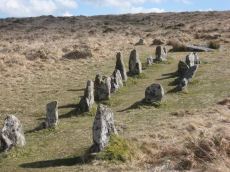
Shoveldown B Stone Row
Prehistoric Dartmoor Walks: Dartmoor Site: Shovel Down Ceremonial Complex
OS Map: SX 65955 86026
HER: MDV6171
Megalithic Portal: 2129
The Stone Rows of GB: Shoveldown 2
PMD: Shovel Down A-B Stone Row
Alternate name: Shoveldown 2 Stone Row
ShortName: SR Shovel B
Butler map: 36.7.2
DPD page: 139
Notes: Worth Row A. Butler Rows 2.('B' SX 65968615 to SX 65968601) Double row to the east. Length 596 ft. Rows 3 ft 6in apart. Row is near Batworthy enclosure and has been much robbed; now just 12 pairs of stones and 15 single. Spacing of stones along the rows is around 6 ft. Two fallen stones next to the circle are much the largest in the row; one is 11 ft 6in, in length. and the other 7ft 4 in. The southern end of the row terminates in the Fourfold Circle (SX 68 NE 17). Lethbridge 139-145, diagram p.139.
Nearby sites: SX 65955 86026
Distance: 3.57km
Shoveldown C Stone Row
Prehistoric Dartmoor Walks: Dartmoor Site: Shovel Down Ceremonial Complex
OS Map: SX 65998 85903
HER: MDV14875
Megalithic Portal: 2127
The Stone Rows of GB: Shoveldown 4
PMD: Shovel Down C-F Stone Row
Alternate name: Shoveldown 4 Stone Row
ShortName: SR:Shovel C
Butler map: 36.7.4
DPD page: 139
Notes: Worth Row C, Butler Rows 4. "('C' SX 65948601 to SX 65998590) A double row, 380 feet long, with an average distance of five feet between the rows. Most of the pairs of stones are complete and the southern end terminates in a barrow (SX 68 NE 34). No special feature marks the northern end." Lethbridge 139-145, diagram p.139.
"C: SX 65998592 to SX 65938602. A double row (83 stones visible July '78), with minor breaks; at 40 metres from the northern end it is overlain and mutilated by a reave and later hollow-way. The row terminates at the southern end on a cairn with the remains of a cist (SX 68 NE 34). The apparent north-westward extension as a single stone row, is a denuded probable Bronze Age reave (SX 68 NE 63)."
Nearby sites: SX 65998 85903
Distance: 3.50km
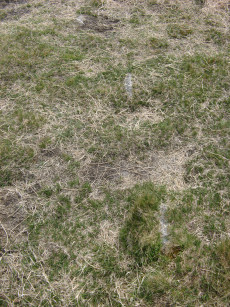
Shoveldown D-G-H-J Stone Row
Prehistoric Dartmoor Walks: Dartmoor Site: Shovel Down Ceremonial Complex
OS Map: SX 66049 85707
HER: MDV6181
Megalithic Portal: 2128
The Stone Rows of GB: Shoveldown 1
PMD: Shovel Down H-K Stone Row
Alternate name: Shoveldown 1 Stone Row
ShortName: SR Shovel DGHJ
Butler map: 36.7.1
DPD page: 139
Notes: Worth Row H, Butler Row 1. This row is considered to be one long partially robbed row - previously listed as four separate rows:-
"D: SX 66028583 to SX 66048568. A single row (47 stones visible July '78) 149.0m long, with no terminal features; it curves slightly to the south west Worth (2) extends it as a reave for a further 50.0m to the north but this extension is straight, on a different alignment, and almost certainly a separate row (see G)."
"G: SX 66008591 to SX 66028585. A single row (25 stones visible July '78), 60.0m long; two gaps (? stone robbing) of 6.0m & 8.0m occur towards the north end. The north penultimate stone (now recumbent) is of much larger slab-like proportions and may have originally served as a blocking-stone."
"H: SX 65998599 to SX 65998595. A single row (24 stones visible July '78), 51.0m long with three gaps of from 5.0m to 8.0m recorded by Pettit (3), but not Worth (2)."
"J: SX 65978625 to SX 65988603. A single row (46 stones visible July '78), 228.0m long, there are no special terminal features. Many gaps of from 3.0m to 47.0m occur throughout the entire length of the row. The southern end has probably been overlain by a later reave (SX 68 NE 63). The northern end most probably extended further northward, and it would appear to have been destroyed by a mining 'rake' of circa 19th century date, and stone robbing? for the nearby Batworthy enclosure walls."
Lethbridge 139-145, diagram p.139.
The photo is taken at SX 66034 85844.
Nearby sites: SX 66049 85707
Distance: 3.37km
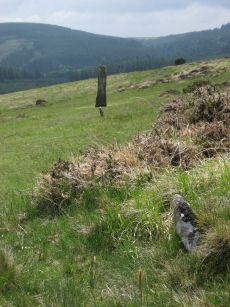
Shoveldown E-F Stone Row
Prehistoric Dartmoor Walks: Dartmoor Site: Shovel Down Ceremonial Complex
OS Map: SX 66017 85840
HER: MDV6179
Megalithic Portal: 2126
The Stone Rows of GB: Shoveldown 5
PMD: Shovel Down G Stone Row
Alternate name: Shoveldown 5 Stone Row
ShortName: SR Shovel E-F
Butler map: 36.7.5
DPD page: 139
Notes: Worth Row G, Butler Rows 5 & 6 ('E')SX 66028581 to SX 66028567) A double row, 485 feet long with 3 1/4 feet between the rows which run almost due north and south, and terminates in a standing stone known as the Longstone (SX 68 NE 39). Fairly complete at the northern end but more ragged towards the south.
('F' SX66028567 to SX 66038549) A double row continuing on almost the same alignment as ('E'), 555 feet long and terminating in a single standing stone, the sole survivor of the Three Boys (SX 68 NE 40). Only a few set stones survive but Ormerod (a) states that in 1858 the pits left by the removal of the other stones of the double row could still be seen.
Lethbridge 139-145, diagram p.139.
Nearby sites: SX 66017 85840
Distance: 3.46km
Shoveldown N.W. 5 Cist
Prehistoric Dartmoor Walks: Dartmoor Site: Shovel Down Ceremonial Complex
OS Map: SX 64389 86247
HER: MDV4394
Megalithic Portal: 45782
PMD: Stonetor Hill
Alternate name: Shoveldown N.W.1 Cist
ShortName: CT:Shovel NW5
Butler map: 37.5.1
Butler Vol 5: p.202 & Fig.145
Grinsell: GID 1
Notes: NB. NGR from PMD is SX64398640. "The remains of a Bronze age cairn and cist which form part of a cairn cemetery on Long Ridge, known locally as Langridge, overlooking the valley of the River North Teign. The cairn has a circular mound which measures 5.2 metres in diameter and 0.5 metres high. The cist measures 0.83 metres square by up to 0.47 metres deep. The capstone, which once covered the cist, now lies 0.7 metres NNW of the cist." Butler Shoveldown N.W.1. - Vol. 2. Map 37.5. (diagram Vol. 5. p.202).
Nearby sites: SX 64389 86247
Distance: 3.16km
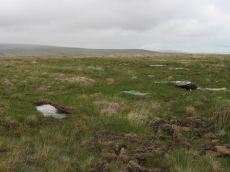
Sittaford Stone Circle
OS Map: SX 63017 82814
HER: MDV110432
Megalithic Portal: 35327
PMD: Sittaford Tor
ShortName: SC Sittaford
Notes: Discovered by Alan Endacott in 2007 as described in Devon Archaeological Society Newsletter No. 117 January 2014. Circle consists of 30 recumbent stones and has a diameter of 32m. It is about 1km from the Grey Wethers which are to the ENE. It is on the same arc as the previously known circles in northeastern Dartmoor.
Nearby sites: SX 63017 82814
Distance: 0.91km
Sittaford Tor Pound
OS Map: SX 6400 8287
HER: MDV6754
Megalithic Portal: 23218
ShortName: PD:Sittaford
Notes: "An oval enclosure lying within Great Stannon Newtake. It is defined by a 4.5m wide and 1.2m high rubble bank surrounding an internal area measuring 53.5m east to west by 39m north to south. An 8.3 metre wide entrance gap on the eastern side by a stony mound. The considerable size of the bank combined with its proximity to a number of ritual monuments within Great Stannon Newtake strongly supports that this enclosure is much more likely to have been used for ritual than domestic purposes and it has consequently been identified as a henge."
Nearby sites: SX 6400 8287
Distance: 0.29km
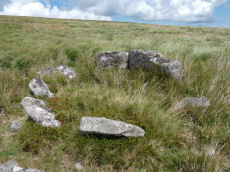
Sittaford Tor Ring Setting Cairn and Cist
OS Map: SX 63479 82641
HER: MDV21894
Megalithic Portal: 45792
PMD: Sittaford Tor
Alternate name: Sittaford Tor S. Ring Setting Cairn and Cist
ShortName: CT Sittaford
Butler map: 34.3
Butler Vol 5: p.183 & Fig.126
DPD page: 125
Turner: D25
Notes: "Cairn 5 metres in diameter, 0.75 metres high. Surrounded by two rings of kerb stones up to 0.75 metres high. Many stones forming the outer ring are recumbent. Mound material up to 0.2 metres high. Inner kerb is 2.8 metres diameter and the outer is 5 metres diameter. Slab in centre may be an intact cist. Grass and rushes. Animal poaching on western side of cairn.". "This mutilated kerbed cairn is situated on a peat-covered moorland slope below Sittaford Tor at 488m OD. It measures about 5m in diameter and comprises a probably (hidden) central cist set within twin concentric kerbs of granite slabs." Lethbridge photo bottom p.125. Butler Sittaford Tor S (Cairn 3) Vol. 2. Map 34.3 (p.112, also Butler Vol. 5. diagram p.183).
Nearby sites: SX 63479 82641
Distance: 0.63km
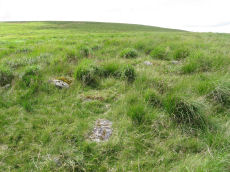
South Teignhead Platform Cairn Circle
OS Map: SX 64084 82827
HER: MDV20908
Megalithic Portal: 45611
PMD: South Teignhead
ShortName: PC S Teignhead
Butler map: 35.17
Butler Vol 5: p.157
Turner: E4
Notes: Oval cairn measuring 12.0m x 8.0m. It is flat-topped apart from a slight hollow in the centre. It appears to have multiple concentric rings of spaced small stones set on edge, with at least six rings being visible on its north side. To the south-east some stones are set at right angles to the rings. Butler in Volume 5 p.157 refers to a 14 x 6 m long cairn on the southern slopes of White Ridge. Presumably he refers to this site.
Nearby sites: SX 64084 82827
Distance: 0.37km

South Teignhead / White Ridge Stone Ring Cairn Circle
OS Map: SX 64168 82656
HER: MDV6754
Megalithic Portal: 35830
PMD: Teignhead Henge
Alternate name: South Teignhead Pound Stone Ring Cairn Circle
ShortName: RC White Ridge
Butler map: 35.18
Turner: A5
Notes: A small circular 'pound' about 0.5km SE of Grey Wethers. It measures 75ft (N-S) by 66ft; the bank composed of small stone and earth is 6-8ft wide and 3ft high. An entrance on the W has one door jamb standing.
Nearby sites: SX 64168 82656
Distance: 0.56km
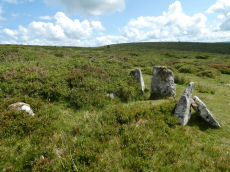
Stannon Little Newtake Ring Setting Cairn and Cist
OS Map: SX 65464 81068
HER: MDV6616
Megalithic Portal: 37598
PMD: Stannon Newtake
Alternate name: Stannon Newtake E. Ring Setting Cairn and Cist
ShortName: CT Stannon New
Butler map: 35.21.1
DPD page: 124
Grinsell: LYD 29
Turner: D16
Barrow Report: 57
Notes: "Cairn survives as a 4.5 metre diameter mound up to 0.5 metres high. The western edge is denoted by a kerb of edge set slabs up to 1.15 metres high. The eastern edge is beneath a later boundary bank. A cist in the centre is a rectangular pit 1.2 metres by 0.5 metres denoted by edge set slabs". Butler Stannon Newtake E. - Vol. 2. Map 35.21 (diagram p.168).
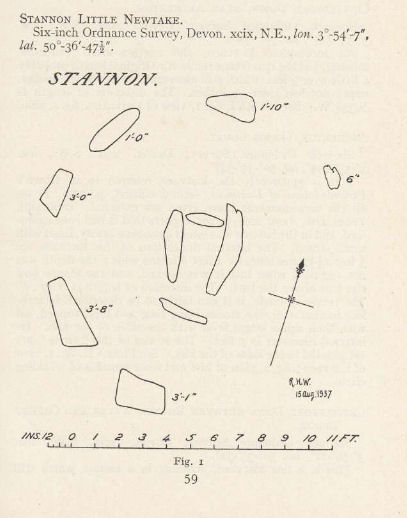
Nearby sites: SX 65464 81068
Distance: 2.61km
Stannon Newtake Stone Row
OS Map: SX 65348 81091
HER: MDV54555
Megalithic Portal: 2144
The Stone Rows of GB: Stannon Newtake
PMD: Stannon Newtake Stone Row
ShortName: SR:Stannon New
Butler map: 35.21
Notes: Possible extension of the White Ridge Stone Row. "Standing stones, possibly a stone row. Forty-six feet S. of the cairn (SX 68 SE 23) are two standing stones, two and a half feet high, their broad planes facing the monument. These, and two others in line, suggest the remains of a stone row, destroyed for materials for an ancient hedge. If a row, it does not point to the centre of the cairn. "
Nearby sites: SX 65348 81091
Distance: 2.52km
Stonetor Brookhead E. Cist
OS Map: SX 6527 8563
HER: MDV13023
Megalithic Portal: 45807
PMD: Stonetor Brook Head
Alternate name: Stonetor Brookhead E.2 Cist
ShortName: CT:Stonetor E2
Butler map: 37.2.2
Butler Vol 5: p.201 & Fig.144
DPD page: 133
Notes: "A mutilated cist situated amongst peat cuttings on the moderate W slope of shovel Down. Only the N endstone, 0.6m long, remains in situ on the edge of a hollow 1.1m N-S by 0.9m and 0.2m deep. An irregular slab 0.15m thick, probably the disturbed coverstone, lies propped up on the endstone. There is no trace of a covering cairn". Lethbridge diagram p.133 and photo top p.133. Butler Vol. 2. Map 37.2 (diagram Vol 5 p.201).
Nearby sites: SX 6527 8563
Distance: 2.87km
Stonetor Hill Cairn Circle
OS Map: SX 6525 8547
HER: MDV49461
Megalithic Portal: 52273
Alternate name: Stonetor Hill 1 Cairn Circle
ShortName: CC:Stonetor 1
DPD page: 133
Turner: G12
Notes: Dubious site. "Two upright slabs situated in the shallow valley bottom above the headmire of the E arm of the Stonetor Brook. The slabs, 1.2m high, are positioned in line 1.0m apart and lie on the boundary of Gidleigh Parish and the Forest of Dartmoor, now Dartmoor Forest parish. The N face of the E stone has the letters 'GP' (Gidleigh parish). The S face is lichen covered. A deep water filled erosion hollow lies on the N side of these stones". Possibly site listed as Stone Circle G12 by Turner. For a photo of this site, see Boundary stone on Stonetor Hill
Nearby sites: SX 6525 8547
Distance: 2.72km
Stonetor Hill Stone Ring Cairn Circle
OS Map: SX 6520 8536
HER: MDV48856
Megalithic Portal: 3478
Alternate name: Stonetor Hill 3 Stone Ring Cairn Circle
ShortName: RC:Stonetor 3
DPD page: 133
Turner: A3
Notes: Possible pound? "The feature consists of a sub-circular earthern bank 25m in diameter and up to 0.4m in height. It is best preserved on the North side where the bank is well defined, flat topped and has a plan width of about 4.0m On the South side the bank has been spread and flattened but still survives to 0.5m in height as a prominent outward-facing scarp, where the natural ground surface falls away from the enclsure. There is no entrance through the bank."
Nearby sites: SX 6520 8536
Distance: 2.60km
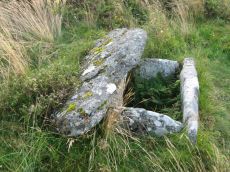
Thornworthy Cist
OS Map: SX 66746 84346
HER: MDV6613
Megalithic Portal: 15453
PMD: Thornworthy
ShortName: CT Thornworthy
Butler map: 35.22
Butler Vol 5: p.64 & Fig.42
DPD page: 137
Grinsell: CHA 3
Turner: E39
Barrow Report: 16 21 56
Notes: Butler Vol. 2. Map 35.22 (p.169, photo on p.136, diagram Vol. 5. p.64).Originally there was a second slightly smaller cist. This was removed after the excavation and re-erected at Torquay Museum. It is now at the High Moorland Visitor Centre at Princetown. See also: Thornworthy 2 Cist
Nearby sites: SX 66746 84346
Distance: 3.12km
Thornworthy Corner (N) Cist
OS Map: SX 6612 8547
HER: MDV6183
Megalithic Portal: 45776
PMD: Downhill from Three Boys
Alternate name: Thornworthy Corner N. Cist
ShortName: CT:Thornwort N
Butler map: 36.7
Grinsell: CHA 2
Notes: "Recorded as a cist by Worth (1932), based on the one remaining stone. 1991 survey thought it more likely the result of stone clearance for the nearby newtake wall" Butler Vol. 2. Map 36.7.
Nearby sites: SX 6612 8547
Distance: 3.25km
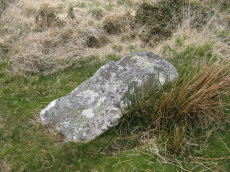
Three Boys Standing Stone
OS Map: SX 66028 85486
HER: MDV6180
Megalithic Portal: 10369
The Stone Rows of GB: Shoveldown 6
PMD: Three Boys
ShortName: SS Three Boys
Butler map: 36.6
Notes: Terminal for stone row - one of 3 stones. 3 standing stones, of which only one remains; sometimes claimed as remains of burial chamber. This record has two entries, this one as a standing stone as widely reported, but also as reported cairn or tomb, see Three Boys Reported Cairn, SiteID=1268
Nearby sites: SX 66028 85486
Distance: 3.19km

West Vitifer Cist
OS Map: SX 67573 82799
HER: MDV6615
Megalithic Portal: 34980
PMD: Chagford Common
ShortName: CT WestVitifer
Butler map: 25.11
Grinsell: CHA 4
Barrow Report: 16
Notes: "Possible location of a Bronze Age cist, although when subject to field investigation in November 2002 the site was not found" "The cairn was partially excavated in 1897 by the Barrow Committee of the Devonshire Association. This working revealed a ring of slabs surrounding a cist which had not been previously examined. In the cist there was a complete Bronze Age beaker together with charcoal but no trace of a burial." Cairn survives, restored urn thought to be in Plymouth museum. See: Sixteenth Barrow Report 1897. Butler Vol. 2. Map 25.11 ( p.32).
The author visited this site on 10 May 2024. I took photos of a possible candidate but I was unconvinced I had located the site so a wide search was undertaken of the vicinity within approx. 100 m. My initial conclusion is that the site cannot be located. However, as a desktop exercise on 23/05/24 I'm inclined to think I had actually located it. It is the dip behind the stone which appears on the RHS of the photo. This coincides within a very short distance with the location I had previously determined using satellite and also to the location given in the scheduled monument SX 67571 82800.
Nearby sites: SX 67573 82799
Distance: 3.72km
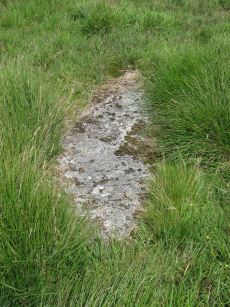
White Ridge Standing Stone
OS Map: SX 64162 82653
HER: MDV6771
Megalithic Portal: 51338
PMD: South Teignhead
Alternate name: South Teignhead Standing Stone
ShortName: SS White Ridge
Butler map: 35.18
Notes: Possible recumbent standing stone. "A small circular 'pound' about 350 yards (sic) SE of Grey Wethers. It measures 75ft (N-S) by 66ft; the bank composed of small stone and earth is 6-8ft wide and 3ft high. An entrance on the W has one door jamb standing; this was excavated but nothing was found except a very fine flat stone on the subsoil which measured 9ft long by 3-4ft wide. Trial pits were dug inside the enclosure without success." TDA Vol. 34 pp.164 (1902)
Nearby sites: SX 64162 82653
Distance: 0.56km
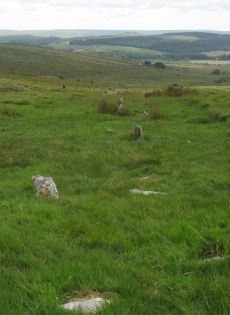
White Ridge Stone Row
OS Map: SX 65420 81661
HER: MDV6642
Megalithic Portal: 4145
The Stone Rows of GB: White Ridge
PMD: White Ridge Stone Row
ShortName: SR White Ridge
Butler map: 35.20
DPD page: 125
Notes: "A double stone row, 620 ft in length from the centre of a cairn at the north end, running nearly due south and slightly downhill. Well preserved at the north end for a short distance but becoming more dilapidated as it approaches the newtake wall at the south end". Lethbridge diagram p.124 and photo top p.125.
Nearby sites: SX 65420 81661
Distance: 2.14km
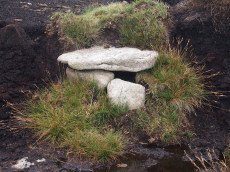
Whitehorse Hill Cist
OS Map: SX 61735 85482
HER: MDV66367
Megalithic Portal: 29778
PMD: White Horse Hill
ShortName: CT Whitehorse
DPD page: 131
Notes: This cist was excavated in August 2011. It possibly featured on an 1892 map by John Chudleigh in An Exploration of Dartmoor's Antiquities. It was re-discovered in 1999 and recently excavated. Carbon dating suggests it is Bronze Age in date. Dates for the top of the cist gives 2800-1890BC and for the bottom of the cist 3650-3100BC. Provisional carbon dates for artifacts suggest the remains are Bronze Age (1900-1500BC). Inside the cist an animal hide bag was found containing cremation remains including a number of artefacts including amber beads (amber would have been imported from overseas), wooden ear studs, a delicate bracelet studded with tin beads, a textile fragment with detailed leather fringing and a unique coiled bag.
There is some good coverage on the Legendary Dartmoor website, see: Whitehorse Kist 1, Whitehorse Kist 2 and Whitehorse Kist 3.
See also DNPA: Update on Whitehorse Hill Cist excavation and Dartmoor tomb treasure horde uncovered by archaeologists. Not listed in Butler - relevant map of area is Vol. 2. Map 41. Lethbridge pp.131-132
Nearby sites: SX 61735 85482
Distance: 3.18km
Yardworthy Stone Row
OS Map: SX 6760 8439
HER: MDV61337
Megalithic Portal: 6333471
The Stone Rows of GB: Yardworthy
PMD: Yardworthy
ShortName: SR:Yardworthy
Notes: "Stone row in Yardworthy Newtake, an area of rough pasture that has since undergone some stone clearance. Apparently the remains of a double row it starts 3.0 metres from a low barrow at SX67608438 and extends to the north-east for 7.0 metres. The north-west side consists of four stones, 2.0 to 2.5 metres apart. The south-eastern side about 1.4 metres distant has only one stone and two turf humps which may conceal others. Visible stones are barely 0.1 metres high. Immediately beyond the north-east end is a hollow or stone pit about 4.0 by 2.0 metres diameter. This, and clearance in the area may have destroyed any continuation."
Nearby sites: SX 6760 8439
Distance: 3.94km